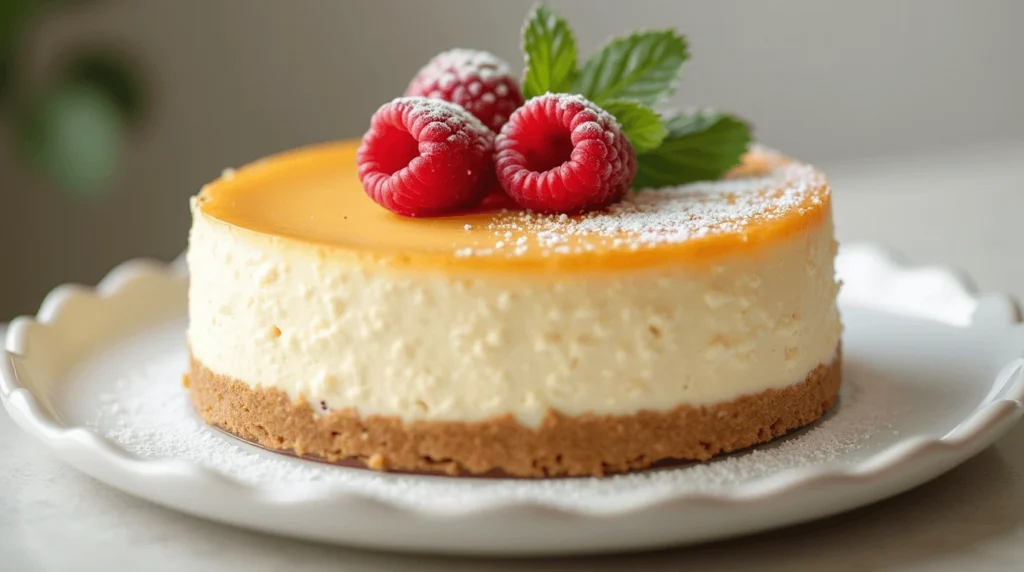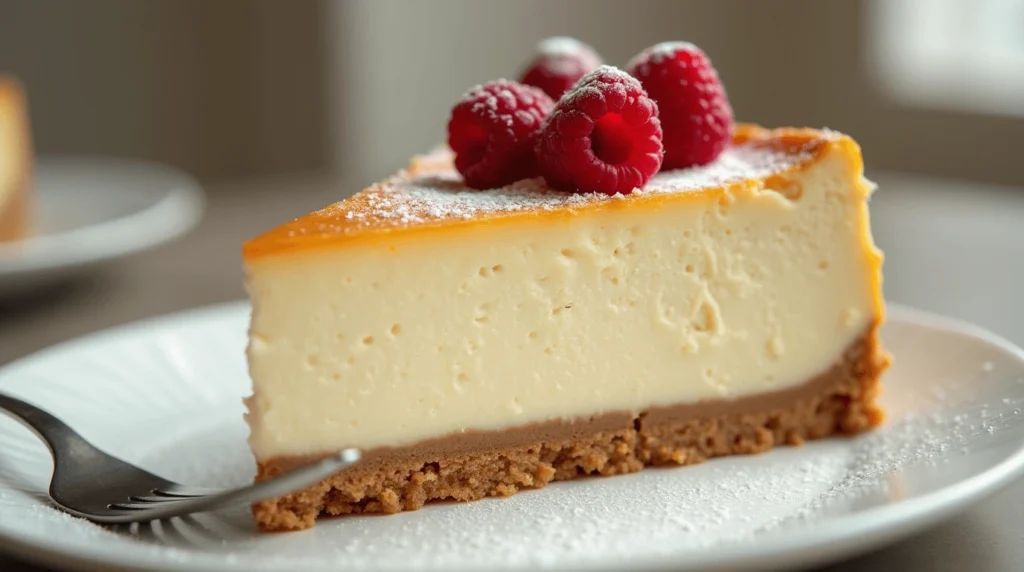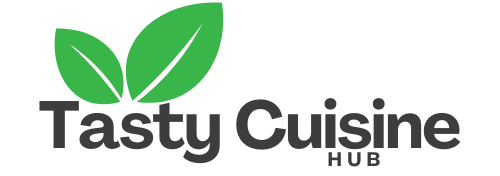Why You’ll Love This Classic Cheesecake
If you’re craving a rich, creamy dessert that’s as simple to make as it is delicious, then this classic cheesecake recipe is exactly what you need. Ready in under two hours and served up in perfect slices, it’s the ideal dessert for any occasion—whether it’s a casual family dinner or a festive gathering with friends. What makes this cheesecake stand out is its irresistible smooth texture, a buttery graham cracker crust, and a hint of vanilla that pairs beautifully with the creamy filling. Plus, it requires just a few basic ingredients that you probably already have in your pantry!
This cheesecake is everything you’re looking for in a dessert—easy to make, incredibly creamy, and the perfect crowd-pleaser. Whether you’re a seasoned baker or just beginning, this classic cheesecake is sure to impress.
| Activity | Time |
| Prep Time | 15 minutes |
| Cook Time | 50 minutes |
| Chill Time | 3 hours |
| Total Time | 4 hours |
| Serves | 8-10 people |
Table of Contents
Key Ingredients for Classic Cheesecake + Substitutions
For the Cheesecake Filling:
- Cream Cheese (2 packages, softened): This is the key to that signature creamy texture that makes a cheesecake irresistible.
- Granulated Sugar (1 cup): The perfect amount of sweetness for a smooth, balanced filling.
- Vanilla Extract (2 teaspoons): This brings a delicious depth of flavor to the cheesecake.
- Eggs (3 large): Eggs provide the structure and help set the cheesecake as it bakes.
- Sour Cream (1 cup): This gives the cheesecake a tangy flavor that complements the richness of the cream cheese.
For the Crust:
- Graham Crackers (1 ½ cups, crushed): These create a buttery, crunchy base that pairs perfectly with the creamy filling.
- Butter (1/2 cup, melted): Adds richness to the crust and helps bind the graham cracker crumbs together.
- Sugar (2 tablespoons): A little sweetness for the crust, balancing the flavor of the cheesecake.
Essential Tools for Making Classic Cheesecake
To make this classic cheesecake, you’ll need a few basic tools that help ensure smooth preparation and an easy cleanup.
- Springform Pan: The best tool for a cheesecake, allowing you to remove the sides once it’s set. If you don’t have a springform pan, you can use a regular round cake pan but be mindful of removing the cheesecake.
- Mixing Bowls: A large bowl for mixing the cheesecake filling and a smaller bowl for the crust mixture.
- Electric Mixer: This will help beat the cream cheese smoothly without lumps. If you don’t have one, you can use a hand whisk, but it will take more time and effort.
- Measuring Cups & Spoons: Essential for getting the proportions of ingredients just right.
- Rubber Spatula: For scraping down the sides of the bowl and mixing the ingredients thoroughly.
- Baking Sheet: If you’re worried about any leaks from your springform pan, place it on a baking sheet while baking to catch any drips.
Step-by-Step Guide to Perfect Classic Cheesecake”
Follow this simple guide to create a perfectly creamy cheesecake.
- Prepare the Crust
Start by crushing your graham crackers into fine crumbs. You can use a food processor, or place them in a zip-top bag and crush them with a rolling pin. Once crushed, combine the crumbs with sugar and melted butter, then press the mixture into the base of your springform pan. Make sure it’s evenly spread and packed down. - Make the Cheesecake Filling
Beat the softened cream cheese in a mixing bowl until smooth and creamy. Add sugar and vanilla extract, continuing to beat until well combined. Add the eggs one at a time, beating well after each addition. Stir in sour cream until the mixture is perfectly smooth. - Assemble and Bake
Pour the cheesecake filling over the crust, smoothing it with a spatula. Bake in a preheated oven at 325°F (163°C) for about 50 minutes. The edges should look set, but the center should still slightly jiggle. This gives the cheesecake a smooth texture after chilling. - Chill the Cheesecake
Allow the cheesecake to cool to room temperature. Then, cover it with plastic wrap and refrigerate for at least 3 hours, or preferably overnight, to ensure it sets fully. - Serve
Carefully remove the cheesecake from the springform pan, slice it, and serve! Add any desired toppings, such as fresh fruit or whipped cream, to elevate the dessert.

Why This Classic Cheesecake Stands Out”
What makes this cheesecake recipe truly special is its simplicity and versatility. The classic combination of cream cheese, eggs, and vanilla creates a smooth, creamy filling that’s rich yet balanced. The graham cracker crust adds just the right amount of crunch to complement the velvety filling.
The real secret behind this cheesecake’s success is in the baking technique—baking it at a lower temperature ensures that the filling cooks gently, resulting in a smooth texture without cracks. By allowing it to chill properly, you get a dense and creamy dessert that holds its shape when sliced. This cheesecake is a timeless dessert that never fails to impress.
Delicious Variations for Classic Cheesecake”
While this classic cheesecake recipe is delicious on its own, there are plenty of fun variations you can try:
- Fruit Topping: Add a fresh berry topping such as strawberries, raspberries, or blueberries for a burst of freshness.
- Chocolate Cheesecake: Incorporate melted chocolate into the cheesecake filling for a rich, indulgent twist.
- Caramel Cheesecake: Drizzle the top of your cheesecake with caramel sauce for a sweet, buttery finish.
- Vegan Cheesecake: Substitute the cream cheese for cashews and coconut cream, and use a dairy-free crust to create a plant-based version.
- Cheesecake Bites: For a fun party treat, make mini cheesecakes in muffin tins and top with your favorite fruits or sauces.
You can get creative with toppings, crusts, and flavorings to make this cheesecake truly your own.
Expert Tips for Perfect Classic Cheesecake”
- Don’t Overmix: When preparing the filling, avoid overmixing the batter. Overmixing can cause air bubbles, which can lead to cracks during baking.
- Room Temperature Ingredients: Make sure your cream cheese and eggs are at room temperature before mixing. This ensures a smoother filling and prevents lumps.
- Use a Water Bath: To prevent cracking, bake your cheesecake in a water bath. Wrap the outside of your springform pan with foil to prevent leaks, then place it in a larger pan filled with about an inch of hot water.
- Cool Gradually: After baking, turn off the oven and let the cheesecake cool inside for 30 minutes. This prevents a sudden temperature change that can cause cracks.
- Chill Properly: Let the cheesecake chill for at least 3 hours in the refrigerator, but overnight is even better. This allows the flavors to set and improves the texture.
Storage & Reheating Tips for Classic Cheesecake
Once you’ve made your classic cheesecake, it’s important to store it properly to maintain its freshness.
- Storage: Store leftover cheesecake in an airtight container or wrap it tightly in plastic wrap. It can stay fresh in the refrigerator for up to 5 days. Make sure to keep it well-covered to prevent it from absorbing odors from other foods in the fridge.
- Freezing: Yes, you can freeze cheesecake! To freeze, first allow the cheesecake to cool completely, then slice it (if desired) and wrap each slice individually in plastic wrap, followed by aluminum foil. Store the wrapped slices in a freezer-safe container or bag. You can freeze cheesecake for up to 2 months. When you’re ready to enjoy it, thaw the cheesecake in the fridge overnight for the best texture.
- Reheating: Cheesecake is best served chilled, but if you prefer to warm it slightly, you can do so by letting it sit at room temperature for about 15-20 minutes before serving. If you’ve frozen individual slices, just let them thaw in the fridge overnight.
Avoid These Mistakes When Making Classic Cheesecake”
Making a cheesecake is simple, but there are a few common pitfalls that can affect the texture and flavor. Here are some mistakes to avoid:
- Overmixing the Filling: Be careful not to overmix the filling. Overmixing can incorporate too much air, which may lead to cracks on the top of your cheesecake.
- Not Using Room Temperature Ingredients: Using cold cream cheese or eggs can cause lumps in your cheesecake filling. Always bring your ingredients to room temperature before mixing.
- Skipping the Water Bath: A water bath helps prevent cracks and ensures the cheesecake cooks evenly. If you don’t have a water bath, consider baking at a lower temperature to avoid overcooking the edges.
- Opening the Oven Door Too Early: Avoid opening the oven door during the first 40 minutes of baking. Sudden temperature changes can cause cracks.
- Not Allowing Enough Cooling Time: Don’t skip the cooling phase. Let your cheesecake cool in the oven with the door cracked for 30 minutes before removing it, then chill it in the fridge for several hours or overnight.
Your Questions About Classic Cheesecake, Answered
Can I make cheesecake in advance?
Yes, cheesecake is perfect for making ahead! It benefits from resting in the fridge overnight, allowing the flavors to fully set. Just make sure it’s properly covered to avoid absorbing any unwanted smells.
Can I double this cheesecake recipe for a larger crowd?
Absolutely! If you’re expecting more guests, you can double the ingredients. Just be sure to use a larger pan and adjust the baking time. You may need to bake the cheesecake a bit longer, so check for doneness by gently shaking the pan—if the center still jiggles slightly, it’s ready.
What can I serve with cheesecake?
Classic cheesecake is delicious on its own, but you can pair it with a variety of toppings such as fresh berries, chocolate sauce, or whipped cream. You can also serve it with a side of coffee for an extra touch.
How can I make cheesecake without a springform pan?
If you don’t have a springform pan, you can use a regular round cake pan, but be careful when removing the cheesecake. You might want to line the pan with parchment paper to make it easier to lift out the cheesecake once it’s set.
Why is my cheesecake cracked?
Cracks are often caused by overmixing the batter or exposing the cheesecake to sudden temperature changes. Be sure to follow the steps carefully, use room temperature ingredients, and bake at a low temperature in a water bath to reduce the chance of cracks.
What to Serve with Classic Cheesecake”
Pairing your classic cheesecake with complementary sides can elevate the dessert experience. Here are a few ideas to create the perfect cheesecake experience:
- Fresh Berries: The natural sweetness and slight tartness of fresh berries such as strawberries, raspberries, and blueberries balance the richness of the cheesecake. A drizzle of berry sauce or a handful of whole berries on top can add a pop of color and flavor.
- Whipped Cream: For a simple and indulgent touch, a dollop of freshly whipped cream on top of each slice enhances the creamy texture of your cheesecake.
- Coffee: Cheesecake pairs beautifully with a warm cup of coffee. For a more sophisticated twist, try a rich espresso for a contrast to the sweetness.
- Light Side Salad: If you’re serving cheesecake as part of a meal, consider a fresh Caesar salad or a simple arugula salad dressed in lemon vinaigrette. The freshness of the salad balances the creamy richness of the dessert.
- Chocolate Sauce or Caramel Drizzle: If you want to add more indulgence, drizzle some decadent chocolate or caramel sauce on top. You can also sprinkle some crushed nuts, like pistachios or almonds, for an extra crunch.
For a regional twist, you might also try pairing your cheesecake with a classic New York-style bagel or a serving of poutine for a unique Canadian-inspired meal!

Nutrition Facts for Classic Cheesecake
Here’s a breakdown of the nutrition details for a typical serving of classic cheesecake:
| Nutrient | Per Serving (1 slice) |
| Calories | 310 kcal |
| Total Fat | 22g |
| – Saturated Fat | 14g |
| – Unsaturated Fat | 6g |
| – Trans Fat | 0g |
| Cholesterol | 65mg |
| Sodium | 210mg |
| Total Carbohydrates | 25g |
| – Fiber | 0g |
| – Sugars | 20g |
| Protein | 5g |
| Vitamins | Vitamin A (10% DV), Vitamin C (2% DV) |
| Minerals | Calcium (8% DV), Iron (2% DV) |
| Dietary Details | Contains Dairy, Gluten |
| Special Diet Suitability | Not suitable for Vegan or Gluten-Free diets |
| Allergens | Dairy, Gluten |
Note: Nutritional values can vary based on the specific ingredients used and portion sizes.
The Story Behind Classic Cheesecake
The history of cheesecake dates back thousands of years. The earliest recorded cheesecake recipe dates to ancient Greece, where it was served to athletes during the first Olympic Games in 776 B.C. Greeks would prepare a version made with simple ingredients such as cheese, honey, and wheat, which was then baked on hot stones.
The modern version of cheesecake as we know it today has roots in New York, where the famous New York-style cheesecake originated in the early 1900s. It was created using a creamy mixture of cream cheese and heavy cream, leading to the rich and velvety texture that makes it so beloved worldwide.
Over the years, the recipe has evolved, with many regional variations now existing, but the classic cheesecake remains a timeless dessert, symbolizing indulgence and sophistication.
Let’s See Your Classic Cheesecake Creations!
We’d love to hear how this classic cheesecake turned out for you! Leave a comment below or tag us on Instagram with #MyDeliciousCheesecake to share your beautiful creations. Whether you topped it with fresh berries or drizzled it with chocolate sauce, we want to see how you make this dessert your own!
Quick, easy, and delicious—this cheesecake is a must-try for any dessert lover! Don’t forget to rate this recipe and share your tips and variations in the comments below. Happy baking!

